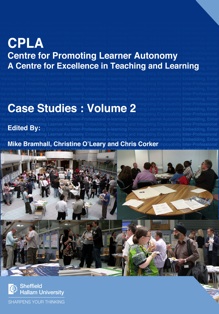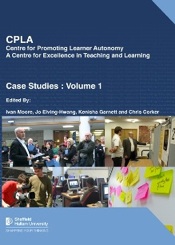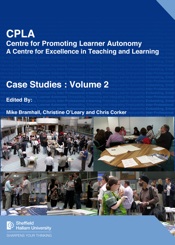CPLA Resources
This section of the website provides some initial resources to stimulate thinking and debate around the meaning of learner autonomy, how it may be developed and how it may be evaluated. It is not systematic or strategic, but rather it gathers together some resources that may be of value to the reader.
- CPLA
Evaluation
Guide
- Case
Studies
- Annotated Bibliography
on Learner Autonomy
- CPLA
Publications
- CPLA
Workshop
presentations
- CPLA
Poster
Presentations
- CPLA
Interim
Evaluation Report
Evaluating Your Teaching Practice
Evaluating your teaching practice is a helpful way of gaining formative feedback from your students. The link above provides a guide to evaluate a learning and teaching project, and for other useful links and resources on evaluation.
The purpose of evaluation is not to audit your project, but to ensure that we can build an evidence-base of the best possible prctice in enhancing student learning at Sheffield Hallam University. The purpose of this booklet is to offer some practical advice and guidelines on evaluating the impact of your teaching practice. Although it focuses on development projects designed to enhance learner autonomy, it will be relevant to any teaching practice. It will explain the significance of evaluation in the context of the overall strategy of the Centre for Promoting Learner Autonomy (CPLA), as well as give some general guidelines as to what you may wish to focus on when designing an evaluation strategy for you particular project or teaching practice. The focus will be to help you to design ways of determining the impact of your teaching practice on the student learning experience.
CPLA Evaluation Guide - Evaluating your teaching practice (MS Word document)
CPLA have provided support for a number of projects aimed to improve the student learning expereince at Sheffield Hallam University. If you are thinking of trying something different to enhance your students' learning experience, we have collated case studies from previous years' projects here and Small Project Schemes.
Case Studies Publications
Volume 1 |
Volume 2 |
 |
 |
| Download Case Studies : Volume 1 (PDF) | Download Case Studies : Volume 2 (PDF) |
What is learner autonomy? Here are some pointers to useful articles and books on learner autonomy, as well as teaching practices that can enhance autonomy in learners, such as EBL, PBL and WBL.
Baume, David (1994), Developing Learner Autonomy, SEDA Paper 84 (Birmingham: Staff and Educational Development Association)
This is a very useful resource book for anyone contemplating engaging with learner autonomy in their teaching practices. Albeit now a little bit outdated, it is a clear and concise introduction to some principles that underlie and inform learner autonomy, as well as some practical suggestions in how to with engage students in order to help them to develop to autonomous learners. Written by a lecturer, it discusses barriers (both institutional and cultural) and issues that relate the lecturers' professional identity and the changing role that students have to take in relation to their own learning processes. This book has a useful section that offers some ways in which arising challenges may be overcome when designing learning and teaching practice that enhances learner autonomy.
Boud, David ed. (1998), Developing Student Autonomy in Learning, second edition (London: Kogan Page)
A very useful book that offers excellent examples of how HE institutions have sought to enhance learner autonomy in students.
Fazey, Della and Fazey, John (2001), 'The Potential for Autonomy in Learning: Perceptions of Competence, Motivation and Locus of Control in First-Year Undergraduate Students', Studies in Higher Education 26 (3): 345-361
This article discusses the findings of a research project that sought to establish 'baseline data indicative for autonomous learning' in first year undergraduates. The central finding was that students appear to have the potential for autonomy, but that this potential need to be fostered and, in a sense, be given a permission to develop. The authors draw some important conclusions that make a case for the importance of fostering autonomy learners, albeit offer no practical examples of how to do this.
Little, David (1991), Learner Autonomy: Definitions, Issues and Problems (Dublin: Authentic)
Although written with school teachers in mind (albeit adult learning is also discussed) with a specific focus on language teaching, this book offers some excellent definitions of what learner autonomy is as a theoretical concept.
Mc Nair, Stephen ed. (1996), Putting Learners at the Centre (Sheffield: Higher Education and Employment Division, Department for Education and Employment)
A good overall introduction to guidance and learner autonomy, which helps to put the philosophy that underlies the thinking behind these issues. Also includes sections on careers guidance and education guidance, which may be helpful to those working on these areas.
The full biblography can be found here
Since 2005, staff who have taken part in CPLA activities have published widely research findings that relate to promoting learner autonomy in students. For a list of such publications, please click here.
CPLA Produced Publications
| Case Studies : Volume 1 | Case Studies : Volume 2 | Case Studies : Faculty Projects |
Conference Proceedings |
 |
 |
 |
 |
| Download (PDF) | Download (PDF) | Download (PDF) | Download (PDF) |
CPLA staff have organised a number of workshops as well as given conference presentations both in the UK and abroad. Power point presentations can be found following this link.
CPLA have hosted many poster exhibitions to promote their project work. This link provides all the posters to date from the exhibitions.
Below are the links the view and download the CPLA Evaluation Report and Appendix. Both documents are PDF files.